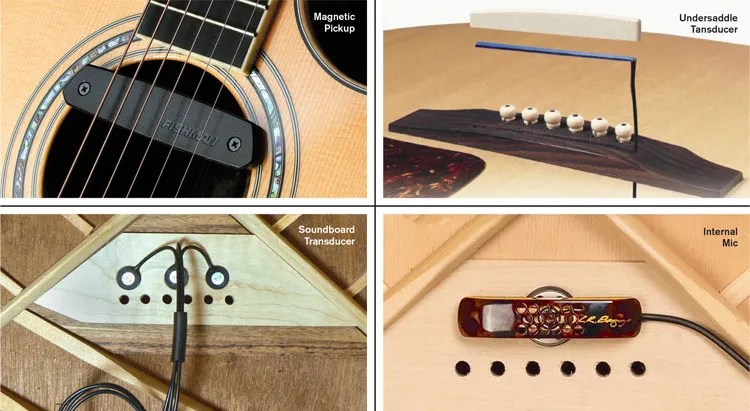So you’ve been playing acoustic guitar for a while now, and you’re ready to take your sound to the next level. Whether you’re a seasoned professional or just a casual strummer, finding the best acoustic guitar pickups can make all the difference in the world. From enhancing your sound to adding versatility to your playing, this comprehensive guide will walk you through everything you need to know to make an informed decision when it comes to choosing the perfect pickups for your beloved instrument. Get ready to unlock a whole new world of sonic possibilities!
The Ultimate Guide to Choosing the Best Acoustic Guitar Pickups
Acoustic guitar pickups are essential for amplifying the sound of your acoustic guitar, whether you’re performing live or recording in a studio. They capture the vibrations of the strings and convert them into electrical signals, which can then be amplified. However, with so many options available, choosing the right pickup for your acoustic guitar can be a daunting task. In this comprehensive guide, we will explore the different types of acoustic guitar pickups, factors to consider when choosing one, popular pickup brands, installation methods, maintenance and repair tips, and much more. So let’s dive in and find the perfect pickup for your acoustic guitar!

1. Types of Acoustic Guitar Pickups
1.1 Magnetic Pickups
Magnetic pickups are the most popular type of pickups for electric guitars. They work by using magnets to detect the magnetic field generated by the vibrating strings. These pickups are known for their warm and rich sound, making them a favorite among many guitarists. However, they may not accurately capture the natural acoustic sound of the guitar.
1.2 Piezo Pickups
Piezo pickups, also known as piezoelectric pickups, utilize the piezoelectric effect to generate electrical signals when pressure or vibration is applied to certain materials. These pickups are commonly found on acoustic guitars and provide a more natural and balanced sound. They are also less prone to feedback, making them ideal for live performances.
1.3 Soundboard Transducer Pickups
Soundboard transducer pickups, also referred to as under-saddle pickups, are placed underneath the bridge saddle of the guitar. They capture the vibrations directly from the saddle, producing a bright and clear sound. These pickups are highly sensitive and can accurately reproduce the natural tone of the guitar.
1.4 Internal Microphone Pickups
Internal microphone pickups, as the name suggests, consist of a microphone installed inside the body of the guitar. They capture the sound directly from the instrument, providing a full and natural tone. However, internal microphone pickups are more susceptible to feedback and require careful placement to avoid unwanted noise.
1.5 Combination Pickups
Combination pickups, also known as hybrid pickups, combine multiple pickup types to achieve a versatile and balanced sound. These pickups often combine magnetic and piezo elements to capture both the warmth of magnetic pickups and the natural tonal qualities of piezo pickups. Combination pickups offer a wide range of tonal possibilities, making them an excellent choice for versatile musicians.
2. Factors to Consider When Choosing Acoustic Guitar Pickups
When selecting the right acoustic guitar pickup, several factors should be taken into consideration to ensure the perfect fit for your instrument and playing style.
2.1 Sound Quality
One of the most crucial aspects to consider is the sound quality produced by the pickup. Different pickups offer varying tonal characteristics, so it’s essential to choose one that complements your playing style and desired sound. Consider whether you prefer a warmer, more vintage sound or a bright and balanced tone.
2.2 Installation Method
The installation method of the pickup is another important factor to consider. Some pickups require professional installation, while others can be easily installed by the guitarist themselves. If you’re not comfortable with modifying your guitar or lack the necessary experience, it is advisable to seek professional help for installation.
2.3 Feedback Resistance
Feedback can be a significant issue when amplifying acoustic guitars. Some pickups are specifically designed to minimize feedback, making them ideal for high-volume performances. If you often perform in loud environments or with a band, choosing a pickup with excellent feedback resistance is crucial.
2.4 Compatibility with the Guitar
Make sure to choose a pickup that is compatible with your acoustic guitar. Certain pickups may require modifications to your instrument, such as drilling holes or making alterations to the bridge or saddle. Consider whether you are willing to make these modifications or if you prefer a pickup that can be easily installed without any permanent changes to your guitar.
2.5 Budget
Acoustic guitar pickups can vary widely in price, so establishing a budget beforehand is essential. Determine how much you are willing to invest in a pickup and consider the value it offers in terms of sound quality, durability, and features. Keep in mind that a higher price does not always guarantee better quality, so it’s important to carefully evaluate your options.

3. Popular Acoustic Guitar Pickup Brands
Now that we have explored the different types of pickups and the factors to consider, let’s take a look at some popular acoustic guitar pickup brands known for their quality and reliability.
3.1 Fishman
Fishman is widely recognized as a leading manufacturer of acoustic guitar pickups. They offer a wide range of pickups, including magnetic, piezo, and combination options. Fishman pickups are known for their exceptional sound quality and feedback resistance, making them a popular choice among professional guitarists.
3.2 LR Baggs
LR Baggs is a renowned brand specializing in acoustic guitar pickups and preamps. Their pickups are favored by many musicians for their transparent sound reproduction and tonal versatility. LR Baggs pickups are designed to capture the true essence of acoustic guitars, ensuring a natural and authentic tone.
3.3 Seymour Duncan
Seymour Duncan is primarily known for their electric guitar pickups, but they also offer a range of acoustic pickups. These pickups are crafted with meticulous attention to detail, ensuring excellent sound reproduction and tonal balance. Seymour Duncan pickups are favored by guitarists who seek clarity, warmth, and musicality in their amplified sound.
3.4 DiMarzio
DiMarzio is another reputable brand that produces high-quality electric and acoustic guitar pickups. Their acoustic pickups are designed to offer a natural and dynamic sound, capturing the nuances and subtleties of your playing. DiMarzio pickups are known for their reliability and durability, making them a popular choice for gigging musicians.
3.5 EMG
EMG is renowned for their innovative and cutting-edge pickups, primarily in the field of electric guitars. However, they also offer a selection of acoustic guitar pickups known for their clarity and precision. EMG’s acoustic pickups are designed to capture every nuance of your playing, producing a pristine and detailed sound.
4. Comparison of Acoustic Guitar Pickups
Now let’s compare different types of acoustic guitar pickups to help you make an informed decision.
4.1 Magnetic Pickups vs Piezo Pickups
Magnetic pickups are known for their warm and rich sound, similar to that of electric guitars. They are ideal for players looking for a more familiar and characteristic tone. On the other hand, piezo pickups produce a more natural and balanced sound, closely resembling the acoustic properties of the guitar. They are especially suitable for fingerstyle players who require a clear and articulate tone.
4.2 Soundboard Transducer Pickups vs Internal Microphone Pickups
Soundboard transducer pickups are highly sensitive and capable of capturing the natural acoustic sound of the guitar with precision. They provide a bright and clear tone while minimizing feedback issues. Internal microphone pickups offer a fuller and more resonant sound, perfectly capturing the acoustic characteristics of the guitar. However, they can be more prone to feedback and require careful placement to avoid unwanted noise.
4.3 Passive Pickups vs Active Pickups
Passive pickups require no external power source and are known for their simplicity and reliability. They offer a natural and uncolored sound, faithfully reproducing the guitar’s tone. Active pickups, on the other hand, require a battery to operate and often include onboard preamps. They offer enhanced control over the sound and are ideal for players who want to shape their tone with precision.

5. Installing Acoustic Guitar Pickups
5.1 Professional Installation
If you are unsure about installing a pickup yourself or lack the necessary skills, it’s recommended to seek professional installation. Professional luthiers or guitar technicians have the expertise and experience to install pickups correctly and ensure optimal performance. They can also provide advice on pickup placement and offer additional setup adjustments if needed.
5.2 DIY Installation
For guitarists who are comfortable working on their instruments, installing a pickup can be a rewarding DIY project. However, it is essential to follow the manufacturer’s instructions carefully and use the appropriate tools. Proper installation ensures optimal sound quality and minimizes the risk of damage to the guitar.
6. Maintaining and Repairing Acoustic Guitar Pickups
To ensure the longevity and optimal performance of your acoustic guitar pickups, regular maintenance and occasional repairs may be necessary. Here are some tips to keep your pickups in great shape.
6.1 Cleaning the Pickup
Periodically clean your pickups using a soft, dry cloth or a specialized pickup cleaning solution. Gently wipe the pickup surface to remove any accumulated dirt or grime. Avoid using abrasive cleaners or solvents that can damage the pickup.
6.2 Handling Feedback Issues
If you experience feedback issues with your pickup, there are several steps you can take to minimize or eliminate it. Experiment with pickup placement, adjust your playing position, and use feedback suppressors or EQ pedals to control unwanted noise. If the feedback persists, seek professional assistance to diagnose and resolve the issue.
6.3 Replacing Faulty Components
In case of component failure or damage, it may be necessary to replace certain parts of the pickup. If you are skilled in electronics, you can attempt to replace the faulty components yourself. However, if you are unsure or unfamiliar with electronics, it’s best to consult a professional to avoid causing further damage.

7. Tips for Great Acoustic Guitar Pickup Performance
To get the most out of your acoustic guitar pickup, consider implementing these tips for optimal performance.
7.1 Finding the Optimal Pickup Placement
Experiment with different pickup placements to find the spot that captures the best sound from your guitar. Consider factors such as string balance, feedback resistance, and tonal characteristics. Moving the pickup slightly closer to the bridge can produce a brighter sound, while placing it closer to the neck can result in a warmer tone.
7.2 Using Preamps and EQs
Preamps and EQ pedals can significantly shape and enhance the sound of your acoustic guitar pickup. They allow you to fine-tune the tonal characteristics, adjust the volume, and control any unwanted frequencies. Experiment with different settings to find the desired sound for various playing styles and environments.
7.3 Experimenting with Different Pickup Combinations
If your guitar is equipped with multiple pickups or a combination pickup, take advantage of this versatility. Explore different pickup combinations to discover unique and interesting tonal possibilities. Mixing magnetic and piezo pickups, for example, can result in a rich and complex sound.
8. Frequently Asked Questions (FAQs)
8.1 What is the purpose of an acoustic guitar pickup?
The purpose of an acoustic guitar pickup is to capture the vibrations of the strings and convert them into electrical signals. These signals can then be amplified and reproduced through speakers or recording equipment.
8.2 Can I use electric guitar pickups on an acoustic guitar?
Electric guitar pickups are not recommended for use on acoustic guitars. Acoustic guitar pickups are specifically designed to capture the unique tonal characteristics and nuances of acoustic instruments, whereas electric guitar pickups are designed for solid-body electric guitars.
8.3 How long do acoustic guitar pickups last?
The lifespan of acoustic guitar pickups can vary depending on various factors such as usage, maintenance, and quality. With proper care and maintenance, pickups can last for many years. However, components may eventually wear out or become faulty, requiring replacement.
8.4 Can I install acoustic guitar pickups on my own?
Yes, it is possible to install acoustic guitar pickups on your own, but it requires a certain level of skill and knowledge. If you are confident in your abilities and comfortable working on your instrument, DIY installation can be a rewarding experience. However, if you are unsure or lack the necessary skills, it’s best to seek professional installation.

9. Conclusion
Choosing the right acoustic guitar pickup is essential for capturing the true essence of your instrument and enhancing your playing experience. Consider the different types of pickups available, the factors to consider when making a decision, and the popular brands known for their quality and reliability. Whether you prefer the warmth of magnetic pickups or the natural sound of piezo pickups, there is a perfect pickup out there for you. Install it correctly, maintain it regularly, and experiment with different settings to unlock the full potential of your acoustic guitar pickup.






